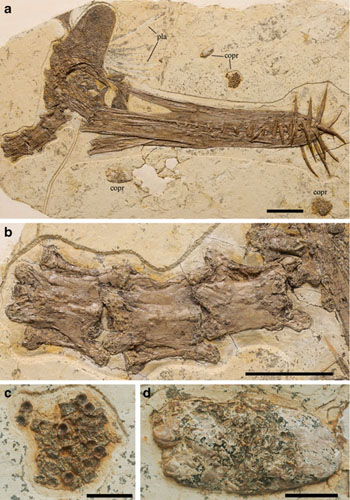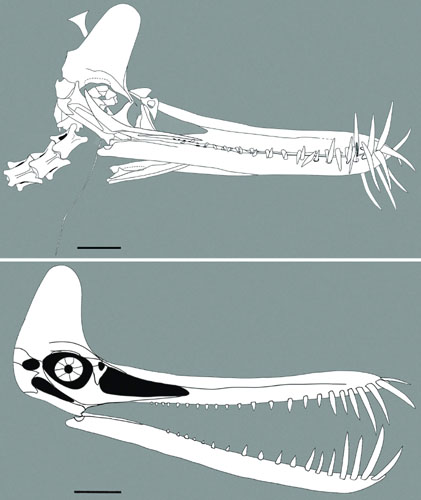Although paleontologists have greatly increase the pterosaur diversity in the last decades, particularly due to discoveries made in western Liaoning, China, very little is known regarding pterosaur biogeography. An international team led by Dr. WANG Xiaolin, Institute of Vertebrate Paleontology and Paleoanthropology, Chinese Academy of Sciences, described a new pterosaur,
Guidraco venator gen. et sp. nov., from the Early Creataceous Jiufotang Formation, western Lianing, China, adding significantly to our knowledge of pterosaur distribution and enhancing the diversity of cranial anatomy found in those volant creatures, researchers report in the April 2012 issue of the journal of Naturwissenschaften.
The specimen, skull with most elements articulated or in close association and the anterior portion of a neck, was unearthed from the Early Cretaceous Jiufotang Formation, Sihedang, Lingyuan City, western Liaoning, China. The skull is 380 mm long (measured between the tip of the premaxillae and the posterior margin of the squamosal), with the rostrum (length: 205 mm) occupying 54% of the cranial length.
Guidraco has a nasoantorbital fenestra, a typical trait of the Pterodactyloidea. It has an unusual upward-directed frontal crest and large rostral teeth, some of which surpass the margins of the skull and lower jaw when occluded. It differs from the pteranodontoid Istiodactylidae and the Pteranodontidae by features such as the dentition and the shape of the nasoantobital fenestra. A frontal crest is present in pteranodontids but, in all cases, differs from that of
Guidraco.
The cranial morphology clearly indicates that
Guidraco is closely related to a rare taxon,
Ludodactylus, from the Brazilian Crato Formation of Araripe Basin, with whom it shares the rounded ventral margin of the orbit and an extensive frontal crest. The main differences found in the Chinese taxon that justifies the separation at a generic level are the more inclined rostral teeth, the direction and position of the frontal crest, the absence of a spike-like lacrimal process, the comparatively smaller nasoantorbital fenestra, and the more constricted ventral portion of lower temporal fenestra.
Luddodactylus was reported to bear a dentary crest, but none could be found in
Guidraco.
“Our overall knowledge regarding the distribution of those volant vertebrates is still very limited compared to other Mesozoic reptiles such as nonavian dinosaurs. In particular, the paucity of the African record, where most specimens are rather incomplete, hampers a more comprehensive knowledge of the pterosaur evolutionary history. Nonetheless, there have been suggestions that several of the main Early Cretaceous pterodactyloid clades may have originated in Asia such as the Anhangueridae and the Tapejaridae. The occurrence of
Guidraco is consistent with that hypothesis”, said study coauthor Alexander W. A. Kellner, professor at the Laboratory of Systematics and Taphonomy of Fossil Vertebrates, Department of Geology and Paleontology, Museu Nacional Universidade Federal do Rio de Janeiro (UFRJ), Brazil.
“Several cranial elements such as the frontal and the premaxillae are unfused suggesting that this was a subadult animal at time of death”, said WANG Xiaolin, lead author and project designer, “The association of the new specimen with coprolites and the cranial morphology suggest that
Guidraco venator preyed on fish”.
This study was mainly supported by the National Science Fund for Distinguished Young Scholars and the National Basic Research Program of China (973 Program).

Fig.1: Holotype of
Guidraco venator (IVPP V17083), from the Early Cretaceous Jiufotang Formation of western Liaoning, China: complete specimen (a), scal bar 5 cm; cervical vertebrae (b), scal bar 3 cm; and coprolites (c, d), scal bars 1 cm. (Image by WANG Xiaolin)


